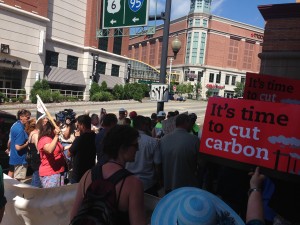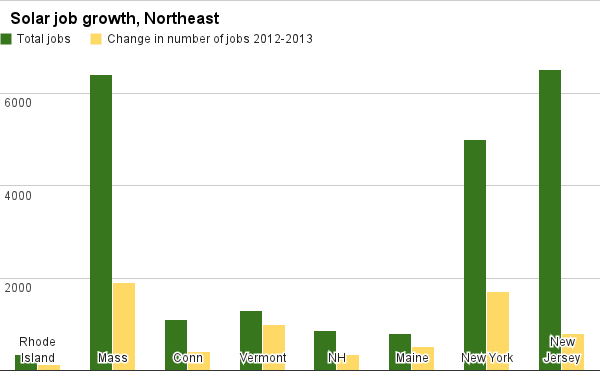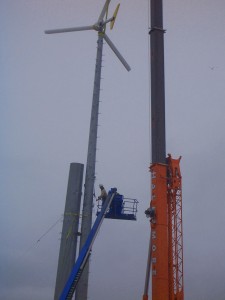
Jeff Grybowski didn’t set out to save the world from climate change. The CEO of Deepwater Wind, which just completed construction of the nation’s first offshore wind farm, wasn’t trying to be the first in the United States to commercially harness the offshore breeze and, in the process, potentially create a new sustainable industry for his home state.
“I freely admit that I didn’t know anything about energy before I started this,” he said, during an interview at Deepwater Wind’s downtown Providence office. “I didn’t think anything of it. I had no opinion.”
The Cumberland native and Brown grad was a corporate attorney in Providence, fresh off serving as chief of staff during conservative Republican Don Carcieri’s first term as governor, when a group from New Jersey approached him about the idea.
“It was the middle of 2008, that summer, when they called me and asked me how do we get a permit to build an offshore wind farm in Rhode Island,” he recalled. “I was doing regulatory law and we all started scratching our heads. But we were lawyers and we wanted to help answer the question.”
The process
Grybowski knew a thing or two about the regulatory process, both from his legal practice and his tenure in the executive branch at the State House, and that proved to be the name of the game.
“For offshore wind in the U.S. it’s never been about construction,” he told me. “It’s always been about the regulations and the legal structure that allows it to happen. Obviously we build things that are as big and as complex as an offshore wind farm. The offshore oil and gas, that stuff is much bigger. The question is can we as a society agree how to build these things, where to build them and what steps you need to take in order to get, let’s call it, community sign off. It was the newness of it, that was the biggest obstacle.”
The Block Island wind farm had to win approval from more than 20 federal, state and local government agencies before construction could start, he said.
“It was great that the U.S. Department of Energy says we think offshore wind is a huge resource and we should develop it,” he said, “but the reality is that really wasn’t as important to us as whether the town of New Shoreham thought it was a good idea.”
Navigating the regulatory process, Grybowski said, is Deepwater Wind’s “core competency.”
He explained, “You need to take it to not only all the agencies of the federal government and people who need to say yes, or who have a veto, and then you bring it down to the state government, all the different agencies, and then down to the local government. And all across that chain you have stakeholders who have the ability to influence the agencies. It’s a huge matrix. You’ve got to find a way to get yourself through that matrix of agencies and stakeholders, and that’s what I did.”
An energy transformation
Along the way, Grybowski also went from being the company’s legal counsel to being the company’s CEO. Eight years after the project was first conceived, Deepwater Wind just finished construction of the first offshore wind farm in the United States. The 5-unit array will produce 30 megawatts of power. Enough, Grybowski said, to power 17,000 average U.S. households.
It’s a relatively small amount of electricity, but Grybowski thinks it’s a big step in what he called an “energy transformation” away from fossil fuels toward renewable energy sources.
“I think offshore wind is about to become a huge component of this energy transformation,” he said. “As a native Rhode Islander I might have been quicker than others to recognize how ideally suited this state was because of our proximity to this enormous resource and because of some of the logistical advantages we have.”
It’s an obvious opportunity for the Ocean State, he thinks.
“We don’t generate a lot of resources locally,” Grybowski explained. “Coal gets shipped in. Gas gets piped in. We’re the end of the line from an energy perspective. But that’s one of the brilliant things about offshore wind for this region. We’re the beginning of the pipeline here because we control the resource. It’s right off our coast. It’s the single biggest natural resource that we have to produce energy in this region.”
The future for offshore wind
Deepwater Wind is already planning its second project. The company has leased 200 miles of ocean about 15 miles southeast of Block Island that could support 200 turbines, compared to the first farm’s five – or 1,000 megawatts compared to just 30. He thinks there is five times that much potential wind farm energy in the vicinity.
“There’s the capacity for 5,000 megawatts of offshore wind out there,” he said. “That’s just in the area that’s been identified in the near term, what could be developed in the next decade or so. That’s certainly not the limit of what we can do.”
Collectively, all the power plant in New England currently generates some 30,000 megawatts of power, Grybowski said. The northeast can expect offshore wind to meet a more substantial portion of its energy needs when it goes even farther offshore.
“That cable really isn’t that expensive,” he said. “It’s copper and plastic, so a little bit more really doesn’t matter that much. The other difference is it becomes deeper the further out you get so the steel structures that you have to use to put these on the ocean floor get taller and heavier. The equipment that you need to install it becomes bigger. Part of the science of the business is where is that sweet spot. Where is the sweet spot of the benefit of the wind versus the downside of the extra costs of getting to that wind.”
Grybowski added, “It’s a lot like the offshore oil business, forget about the resource. It’s the same kind of analysis we go through.”
Much of the offshore wind industry, he noted, is based on the offshore oil and gas industry. Deepwater Wind President Kris Van Beek relocated from the Netherlands to Providence. “He transitioned from offshore oil and gas to offshore wind and he moved to Rhode Island to do that,” Grybowski said. “He knows how to build things in the middle of the ocean.”
Rhode Island, energy exporter
It’s part of the energy transformation he spoke about.
“Unfortunately, the change from a micro-perspective seems really slow but I think the change is pretty inevitable,” Grybowski said. “It’s inevitable that, here in the Northeast, we are going to be building a lot of offshore wind in the coming decade. It’s impossible for us to meet our energy needs, and doubly impossible to address our energy needs and address climate change in a meaningful way, without building a significant amount of offshore wind.”
He was quite confident offshore wind would help us get the Ocean State to sustainability, boasting, “I think Rhode Island – for the first time in, maybe, forever – is going to be an energy exporter.”










